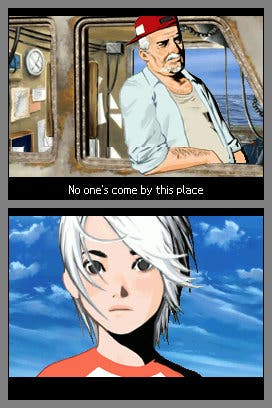Retrospective: Another Code - Two Memories
Remember this?
I love Another Code: Two Memories for what it sets out to do, rather than for what it necessarily achieves. It's a tremendously imaginative game, and contains at least two spellbinding puzzles. It's also peculiarly flawed, not just by an extremely short playing time, but also the madness of including English comprehension tests at various intervals.
Developer Cing made its move from Japanese mobile phone games to the DS in impressive style. While I'd argue Another Code (released as Trace Memory in the States) falls short of their following DS game, Hotel Dusk, it stands as one of the finest examples of the way the DS's peculiar design inspired developers to think uniquely.
It's the day before Ashley Mizuki Robbins 14th birthday. Believing herself orphaned aged three, the young aunt who raised her has revealed that her father is in fact still alive. He's on Blood Edward Island, where the pair are now heading, and wants to be reunited with his daughter after 11 years. Why? That's the point of the game.
It's a game that reminds me that the DS is magical. It's a game that understood why the DS is magical. The developers must have held the console in their hands, just staring at it, for many, many hours. It's been studied, interpreted, and re-imagined not only as a tool for playing an interesting adventure game, but to be used within the game.

Ashley has a suspiciously familiar device called a DAS (Dual Another System). Of course, this was 2005 and rather sadly the immediate effect of seeing the DS in-game is somewhat lost now you're most likely to be playing on a DS Lite or DSi. Hers is an original grey brick DS-alike, and it takes an edge off the resonance.
The DAS is, however, an awful lot more like the DSi than the original DS. It can take photos, rather helpfully. And identify biometric data. (The DSi can do that, right?) It's a tool that isn't fully explained at the start of the game, but is something to do with a mysterious piece of research known as Another. Something both Ashley's parents had been working on before they died. Or didn't die.
But let's rewind slightly. The game's intelligence is revealed at the very start. It's called "Two Memories" for a whole bunch of reasons, and it in fact gives away two of them in the opening cut-scene. You just don't know it yet. Then it does something interesting. It goes silent. White text, tiny, in the middle of a black bottom screen, the top screen black too, slowly appearing. No music, no beeps. It's inauspicious, subtle, and much more interesting for it. Then swoooosh, your DAS loads for the first time, requiring your index fingerprint to begin.
After arriving on the island your aunt Jessica quickly goes missing, leaving Ashley with little choice but to explore. Then things go to a reasonably typical point-and-click adventure place. The game's in 3D, but chooses to show itself from a top-down perspective. It's actually the most effective angle from which you could hope to play, but it makes it strange they didn't just leave it in 2D. No complaints though - it's a very decent use of the DS's 3D capabilities, and makes for some effective cut-scenes as the camera swoops in and out on characters.
However, it's also at this point that the game lapses into some of the very worst features of the adventure, especially including reams of completely non-interactive conversations, and some of the hoariest puzzles imaginable. We're talking 4x4 sliding-tile puzzle levels of unimaginative. Of course, that's to unfairly not repeat that there's also two of the smartest DS puzzles ever, and a ghost called D.


